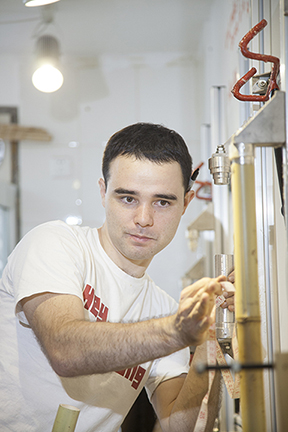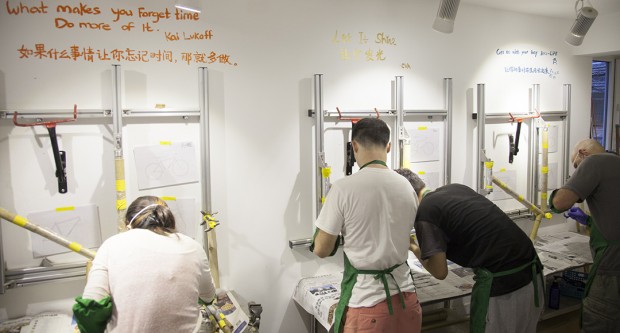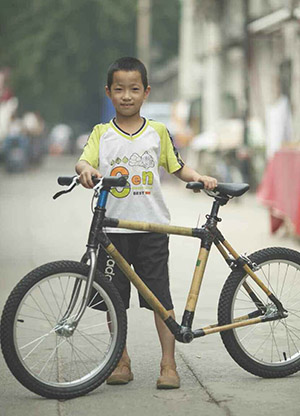
IN A NARROW ALLEY between the twelve-lane roar of Beijing’s second ring road and the touristy mayhem of the Drum and Bell towers is a whitewashed shoebox of a space that is more an extension of the little concrete stoop out front than an actual room. There, on a late-summer Saturday this year, four early risers stand peering at a matter-of-fact list of instructions jotted on a white board. Sweet odors of epoxy and sawdust mask the gritty, metallic smell of the smog blanketing the city.
Knobby sticks of bamboo are lined up on four workbenches. A diagram of a bicycle frame is posted on the wall above each bench. In a day’s time these sticks will be frames and, in a few days more, they will be rolling off down the street with their builders on board.
At the moment, though, the diagrams look like a dare.
Here at Bamboo Bicycles Beijing’s ninth and last bicycle-building workshop of the year, David Chin-Fei Wang ’09, compact and boyish at 28, moves calmly among the participants, taking up a saw and guiding its teeth into a bamboo tube, adjusting a vise or murmuring encouragement to someone who has improvised a solution to a tricky cut. The industrious humility of the scene belies the seriousness of the issue Wang hopes to address: the smog-belching, land-devouring, atomizing urban gridlock that besets cities across Asia as newly wealthy societies embrace the private automobile.
In Beijing, a city once famous for its bicycles, car worship is powerful. Tree-lined bike paths have been leveled to accommodate the city’s six million vehicles. An ever-expanding network of ring roads radiates deeper and deeper into the countryside, and car exhaust accounts for a quarter of the city’s infamous smog. All of this brings little joy to drivers. Though China has become the number one consumer of some of the world’s fastest cars—Lamborghinis, Porsches and Ferraris abound—traffic creeps along at an average speed of under 10 miles per hour.
Wang hopes that, by helping people make fine bikes by hand he can get them to think differently about the way they move around the city.
“It’s not about getting rid of cars,” says Wang. “It’s about starting a conversation about a more diverse mobility culture.”

AFTER GRADUATING FROM Pomona with a degree in Asian Studies, Wang won a Fulbright to study physical fitness programs and nationalism in China, where Mao Zedong once prescribed a regimen of exercises, saying, “The body is the capital of the revolution.” After spending time at Xi’an Jiatong University, though, he found what the students did in their free time more interesting than the program of study.
Moving to Beijing, he took a job with China Youthology, a market research company set up to help brands like Mercedes, Pepsi Co. and Nokia understand how Chinese kids in their teens and twenties make decisions.
As Wang settled in Beijing, he started noticing the old bicycles abandoned around the city, sometimes in heaps and sometimes tethered alone to a fence or tree. It seemed like a waste. Scouring the sidewalks for something he could refurbish, he decided on a Yongjiu brand cruiser from the 1980s.
In his living room he cleaned and stripped the old frame, tinkering with components until everything was back in working order. He painted the bike Fanta orange, added some tiger stripes and set it atop white tires.
Wherever the tiger bike went, it drew curious onlookers. Though China produces more goods than any other country, making stuff by hand is not a pastime for the urban elite. A new middle class has so thoroughly rejected handicraft that even the building of IKEA furniture is mostly outsourced. So Beijingers were uncertain what to make of something so humble made with such obvious care.
Wang, however, wasn’t satisfied. In a country where mining and refinement of metals has tainted rivers, soil and air, he wanted to work with something friendlier to the environment. So naturally, he thought of a resource that China has in great abundance—something beautiful and rapidly renewable, a species of grass that can grow as much as 35 inches in a day, producing a material pliant enough to act as a natural shock absorber, yet durable and stiff enough to handle well.
He thought of bamboo.
The idea of building bicycle frames out of bamboo isn’t new. The first bamboo bicycles were a sensation at the London Stanley Show of 1894, and there are several companies manufacturing and selling them today. In China, a small start-up called Shanghai Bamboo Bicycles has been marketing bamboo bikes and trikes since 2009. But Wang wasn’t interested in selling bamboo bikes—he just wanted to build one.
So he ordered a few lengths of bamboo on Taobao, China’s vaster version of eBay, and set to work figuring out how to make them into a frame. Cobbling together information from the web, Wang worked in the living room of the apartment he shared with friends until he had his first completed bamboo bike.
If his tiger bike attracted attention, the bamboo bike was a showstopper. “People were always stopping me to ask about the bike,” he says. Wang enjoyed the resulting conversations with people from all walks of life, from stolid middle-class citizens to fashion-conscious kids, and in their curiosity, he sensed an opportunity to make a difference.
During his research on the web, he had stumbled onto a number of bike-building workshops in places ranging from Africa to Australia. Maybe, he thought, a workshop to teach people in Beijing to build their own bamboo bikes would deepen the impromptu conversations he was having in the street and create a cascade of conversations about the sustainability of China’s growing car culture.
But first, he had to scale up.
He streamlined his building process and equipment so that four participants could be fairly certain to produce a bamboo frame in just two days. Then, to get a better understanding of his new medium, he traveled to Taiwan, where some of the best bamboo craftsmen taught him which bamboo was best suited for bicycles and how to work with it. Through a Kickstarter campaign, he raised $17,869. A campaign on China’s Dreamore crowdsourcing platform brought in another $3,000, and Bamboo Bicycles Beijing was born.

“I AM YOUR TYPICAL victim of a Chinese education,” laughs Danna Zhu as she works on her bicycle frame. “There are so many of us. They don’t let us make anything in school.” Posing with a bandsaw poised above a tube of bamboo, she asks the gangly bespectacled college dropout at the next station to take her picture. She’s never used a saw before.
At 23, Danna is part of a post-1990 generation of Chinese women widely chastised for their materialism. Back in 2010, when a contestant on a reality TV show told a young bachelor she would “rather cry in the back of a BMW” than take a ride on the back of his bicycle, government regulators ordered reality shows to rein in the broadcast of “incorrect social and love values such as money worship.”
But a car, like a house, remains a prerequisite for many brides and their families.
“They’ll still want cars,” Zhu says of her friends.
Ragtag kids from the hutong—the narrow lane outside—skitter about her as she works, steadying a bamboo tube while she saws or pilfering bamboo scraps to paint on the steps, where an old woman driving a tricycle cart loaded with soda stops to banter. Another grandma pauses on her way from the wet market to give a thumbs up.
The kids seem to appreciate the workshop more than anyone. Against one wall is propped a small bike. The kids built it themselves. For days before the September workshop, they have been coming by, clamoring to know whether Wang has finished adding components like wheels and a seat. On the first day of the workshop, Fei Fei, 9, finds the bike ready at last. Quietly he lifts it out onto the street, pedaling a tentative few yards before disappearing around the corner.
Twice in the course of a few hours, people stop to compliment the bikes and ask how much they cost. When a grizzled man towing recycling on his tricycle cart repeats the query a third time, Wang, visibly piqued, says again that the bicycles are not for sale.
“They think it’s just about selling a bike and it’s not.” What it is about, as he often repeats, is starting a conversation.

IT’S FALL 2014, and Wang is planning an October trip to Massachusetts, with several frames for supporters of his Kickstarter campaign stashed in his luggage. The project is at a turning point—the goal he had set for himself and online funders had been to build 25 bikes. He has doubled that and is on target to make 75 by the end of the year. All of this is good but he wonders how he might further the conversation, perhaps tapping into the kind of enthusiasm he’d seen in the kids on the lane.
He’s looking into partnering with local schools. At the same time, he’s searching for ways to make more and better bikes in as sustainable a way as possible, tracking down villages with abundant bamboo, looking for alternatives to epoxy, and working on kits for people to make bikes at home.
The frames themselves are slowly morphing—he made his first women’s and kid’s prototypes in late summer. Participants have egged him on with requests for things like cup-holders, children’s seats and multi-gear models.
“Right now I’m just concentrating on making the next bike,” Wang says. “I’ll follow my curiosity and hope it just grows.”
Recently, Mercedes, an old client of his, got in touch.
“Benz is doing a lot to create more efficient and sustainable urban mobility,” he says. “It’s to their credit. They see the way things are isn’t sustainable.”
Back on the lane, an old, flat-faced Liberation truck filled with sand for construction has blocked the T-junction. While a bleating line of cars and jerry-rigged motorized tricycle trucks forms along the cross road, an antlike stream of pedestrians and scooters improvise a path through a pile of sand. It’s along this path that two bamboo bicycles slip quietly northward, leaving a Lexus SUV in the dust.
